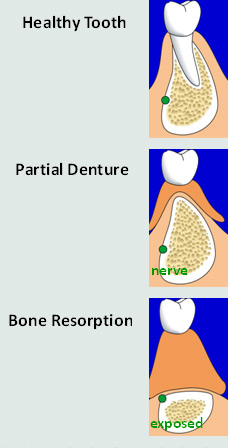 According to the World Health Organization greater than 240 million people are missing one or more teeth throughout North America, Europe and Japan. Having teeth missing can be embarrassing. The misconception is that all teeth missing, or “edentulism” only is limited to “old people”. Unfortunately loss of teeth for whatever reason can occur at any age. There are consequences to tooth loss beyond difficulty chewing, that can affect all aspects of our patients’ lives. Below are the main themes identified in reaction to tooth loss:
According to the World Health Organization greater than 240 million people are missing one or more teeth throughout North America, Europe and Japan. Having teeth missing can be embarrassing. The misconception is that all teeth missing, or “edentulism” only is limited to “old people”. Unfortunately loss of teeth for whatever reason can occur at any age. There are consequences to tooth loss beyond difficulty chewing, that can affect all aspects of our patients’ lives. Below are the main themes identified in reaction to tooth loss:
- Bereavement
- Lowered self-confidence
- Altered self-image, dislike of appearance
- Inability to discuss this taboo subject
- Behaving in a way that keeps the tooth loss a secret
- Altered behavior in socializing and forming close relationships
- Premature aging
Difficulty eating (regardless of your age) can lead you to eat what you can instead of what you should (or want to eat). This change in diet can have negative impact on your health if nutritionally important foods are not eaten.
The report continued: "The elderly edentulous avoid many types of foods, particularly raw vegetables and other hard and tough foods, because they cannot chew these with conventional dentures.
As a result, such individuals consume significantly less protein and other key nutrients – including fiber, calcium, non-heme iron, and some vitamins – than do individuals with teeth.”
Concepts of Edentulism
The jawbone consists of two types of bone: Cortical (hard outer bone) and Cancellous (softer inner bone). Bone supports teeth but will resorb or atrophy then where is no tooth root to stimulate the bone. Bone resorption can lead to changes in facial appearance and potential exposure of the mandibular nerve:
- Loss of "mid-face" support - looking older
- Discomfort and pain
- Changes in facial appearance and nerve exposure
- Creates additional cost and treatment for periodic denture relines (due to bone resorption)
- Tissue-supported prosthesis for replacing teeth, such as partials or dentures, contribute to bone resorption

In summary,bone is necessary for face/lip support and severe resorption can expose nerves, causing pain.
 Course of Treatment
Course of Treatment
There are several options available. This is determined by the patients existing condition, such as how long they have been without natural teeth and how much of their existing bone has resorbed (melted away) and what they want to achieve for their dental health.
Dentures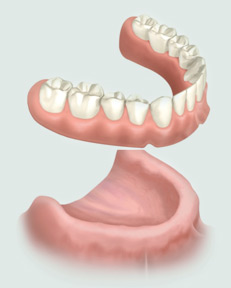
- Benefits
- Least costly approach
- Fast
- Considerations
- Contributes to further bone loss (tissue supported sore spots, nerve exposure, older look)
- Ongoing expense to maintain (relines, denture adhesives and cleaners
- Loose fitting, difficult to eat and speak
- Palatal coverage interferes with normal sensation of food
- Studies reveal lower nutritional state, lower self confidence, lower quality of life.
Overdentures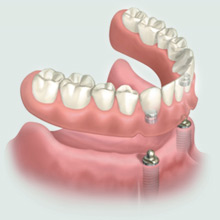
- Benefits
- Next least costly approach
- Fast
- Better fixation of teeth vs denture
- Improved chewing ability
- Considerations
- Contributes to further bone loss
(tissue supported, implant retained)
- Ongoing expense to maintain
(relines, denture adhesives and cleaners
Fixed Implant Bridge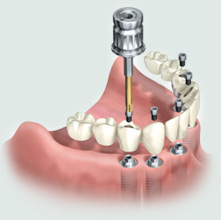
- Benefits
- Best fit, most like natural teeth
- No dietary limitations (maximize nutritional intake)
- Food tastes normal
- Implant supports, implant retained
- Preserves one and facial structure
- Over 40 years of clinical research and use
- Fast - Teeth in an Hour reduces to one clinical visit
- Permanent solution
- No ongoing maintenance and save costs and time
- Considerations
- Can be a larger financial investment
- Longer treatment time when not performed as Teeth in an Hour procedure.
Relative Functional Ability
The following chart is designed to illustrate the ‘functional capacity’ or ‘chewing ability’ of the different treatment options, where moving from a lower denture to an implant retained overdenture to a full implant retained bridge dramatically increases the function – including comfort, chewing ability and stability/retention.
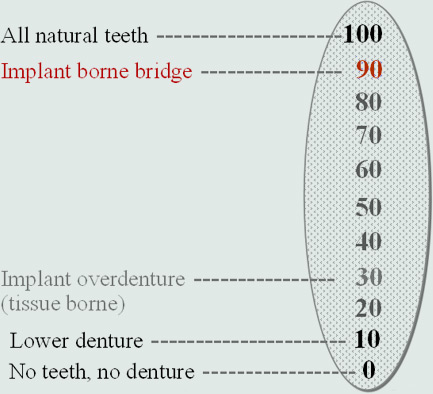
 Or Call: 519-258-6722
Or Call: 519-258-6722
 Or Call: 519-258-6722
Or Call: 519-258-6722